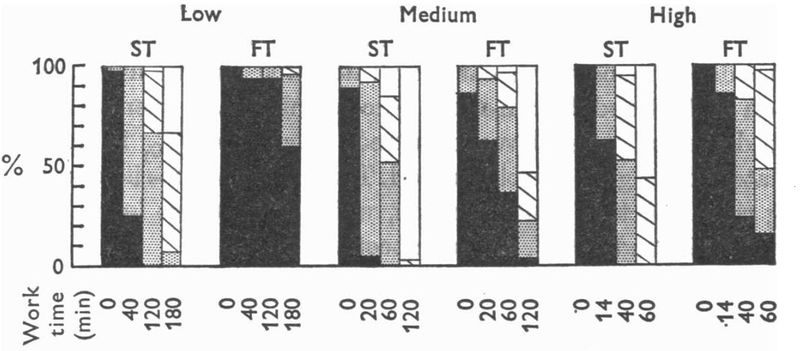Glycogen
From Fellrnr.com, Running tips
Revision as of 17:38, 10 December 2011 by User:Fellrnr (User talk:Fellrnr | contribs)
Glycogen is the critical fuel supply for endurance running.
- Glycogen is formed primarily from the carbohydrates we consume and is stored in our livers and muscles.
- The glycogen in our livers can leave the liver and flow via our blood to our muscles, brains and other organs.
- The human liver typically stores between 90 and 160 grams of Glycogen, or 350 to 650 Calories.
- Blood typically contains less than 20 calories of glucose.
- The glycogen in our muscles can only be used by those muscle fibers.
- Glycogen can also be created from protein via a process called gluconeogenesis, but not from fat.
1 Glycogen Depletion
The chart[1] below shows that muscles do not become glycogen depleted at the same time. At all intensities shown, slow twitch fibers become depleted before fast twitch. The depletion within a fiber type is also not equivalent, with some fibers becoming depleted while others are fully loaded. This pattern implies a pattern of fiber recruitment, where a subset of muscle fibers are recruited until they become exhausted, at which point other fibers are then used. As the slow twitch fibers become exhausted, fast twitch fibers are used in turn.

Glycogen depletion in human muscle fibers. The bars are colored with black indicating high glycogen content through to white indicating glycogen depletion. Three different intensities are shown; high (84% V̇O2max) medium (64 %V̇O2max) and low (31 %V̇O2max) for each of Slow Twitch and Fast Twitch muscle fibers.
2 Further reading
For more details see http://en.wikipedia.org/wiki/Glycogen
3 References
- ↑ Selective glycogen depletion in skeletal muscle fibers of man following sustained contractions http://www.ncbi.nlm.nih.gov/pmc/articles/PMC1331072/